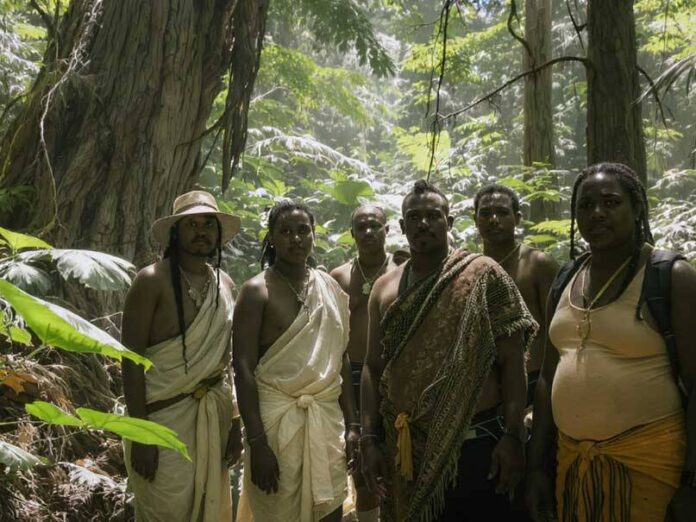Indigenous peoples have long been recognized as vital stewards of the planet’s biodiversity, drawing on ancestral wisdom to maintain ecological balance. According to key data, they manage or own nearly 50% of the world’s landmass (excluding Antarctica), with about 40% of these areas considered protected or ecologically intact {2}. However, their role is not without controversy. A widely cited but disputed statistic claims they safeguard 80% of global biodiversity {2}, {4}, prompting calls for more rigorous evidence amid ongoing environmental injustices {2}. In 2024-2025, news from South America, particularly the Amazon, underscores both their contributions and the threats they face, from deforestation to rights violations. This section provides an overview, integrating factual data with expert analyses to frame the challenges and conservation strides.
The Role of Indigenous Peoples in Biodiversity Conservation
Indigenous communities play an indispensable role in preserving biodiversity, often outperforming formal protected areas through sustainable practices rooted in traditional ecological knowledge. For instance, studies on the Guarani-Kaiowá people in Brazil reveal how their biocultural conservation methods—integrating cultural practices with environmental stewardship—help maintain diverse ecosystems, though urgent action is needed to counter habitat fragmentation {1}. Globally, Indigenous guardian programs, such as those in Canada and Australia, enhance environmental governance by monitoring lands and enforcing community-led rules, yet research highlights gaps in understanding their full impact on self-determination {3}.
In South America, particularly the Amazon, Indigenous territories are less prone to deforestation, safeguarding 25% of the forests and reducing disease spread in surrounding areas [G9], [G11]. Expert analyses emphasize that these groups leverage generational knowledge for agrobiodiversity, using native species for food and medicine, which sustains ecosystems amid climate pressures [G2]. However, challenges abound: environmental injustices, including land grabs and mining, threaten these efforts {2}. A balanced view acknowledges successes, like lower deforestation rates in Indigenous zones, while noting external pressures that undermine autonomy.
Debating the Data: The 80% Biodiversity Statistic and Its Implications
A central debate in 2024 revolves around the claim that Indigenous peoples protect 80% of the world’s remaining biodiversity—a figure popularized by organizations but recently challenged as “baseless” in a Nature commentary {4}. Critics argue it lacks empirical backing, potentially oversimplifying complex conservation dynamics and diverting attention from evidence-based policies {4}. Proponents, however, point to supporting data showing Indigenous management of 50% of global lands, with significant ecological benefits {2}, {5}.
Expert perspectives highlight this tension: while the statistic amplifies Indigenous contributions, its scrutiny underscores the need for robust research [G2]. Sur les réseaux, des discussions appellent à un « financement décolonisé » pour autonomiser directement les communautés et éviter le greenwashing [G15–G20]. Objectivement, ce débat révèle un enjeu plus large : sans métriques fiables, le soutien aux efforts autochtones risque d’être fragilisé. Des approches constructives proposent de raffiner les données via des études collaboratives intégrant l’expertise autochtone.
Key Challenges Facing Indigenous Guardians
Indigenous biodiversity guardians confront multifaceted challenges, including legal battles over land rights, climate-induced disruptions, and human rights violations {2}. In the Amazon, deforestation and mining have escalated, with 2024 reports noting a potential tipping point by 2050 if trends continue [G3]. Studies show that while Indigenous lands exhibit resilience, external factors like illegal logging erode these gains [G11].
Expert insights emphasize health intersections: preserved Amazon forests on Indigenous territories reduce 27 diseases across eight countries, yet degradation heightens risks [G9]. Perspectives vary; some commentators view Indigenous stewardship as a “health shield” against zoonotics, while others critique inadequate global support [G17], [G18]. Critically, these challenges intersect with equity issues—many initiatives impose top-down models, diluting Indigenous control [G12]. A balanced analysis reveals that while threats are dire, they also spur resilience, as communities adapt traditional practices to modern crises.
Emerging Conservation Efforts and Initiatives
Amid challenges, 2024-2025 has seen promising conservation efforts led by Indigenous groups. The Amazon Sacred Headwaters Alliance unites 30 nations to protect 35 million hectares through land rights and youth programs [G8], [G15]. World Bank projects in Brazil’s Xingu region support habitat restoration and sustainable development, involving communities directly [G10].
Trends include innovative financing, like a $50 million bond for Indigenous-led forest protection [G4], and grassroots models channeling funds to Amazon communities [G13]. Expert analyses note a shift toward inclusive governance, with youth leadership driving bioeconomy models that blend tradition with technology [G8]. Solutions under study, such as satellite monitoring in Peru reducing deforestation by 52% [G14], offer scalable paths. Different viewpoints emerge: optimists hail these as empowerment tools, while skeptics warn of corporate co-optation [G12]. Constructively, these initiatives demonstrate that direct funding and technology integration can amplify Indigenous guardianship.
Solutions and Pathways Forward
Concrete solutions focus on empowering Indigenous voices through equitable support. Advocacy for land rights recognition, as pushed by groups like Amazon Watch [G7], is key, alongside education campaigns amplifying stories via social media [G16]. Emerging trends like “adaptive guardianship”—hybrid tech-traditional approaches—hold promise for resilience [G3], [G6].
Expert original insights suggest decolonized funding, where communities control resources fully, to maximize impact [G2]. Actionable steps include donating to organizations like the Amazon Conservation Team [G1], [G5], or supporting policies at UN forums [G13]. Balancing views, while some see technology as invasive, others view it as essential for monitoring threats. Overall, these solutions emphasize collaboration, ensuring Indigenous-led efforts lead global biodiversity strategies.
KEY FIGURES:
- Indigenous peoples protect 80% of the world’s remaining biodiversity: This figure is widely cited but has been disputed in recent commentary as lacking concrete evidence (Source: {2}, {4}).
- Indigenous peoples manage or own nearly 50% of the world’s landmass: Excluding Antarctica, with about 40% of these landscapes considered protected or ecologically sound (Source: {2}).
RECENT NEWS:
- Indigenous Peoples as Guardians of Biodiversity: Indigenous peoples are critical guardians of biodiversity, yet they face numerous challenges such as environmental injustices and human rights violations (Date: 2024, Source: {2}).
- Challenging the 80% Statistic: A recent commentary in Nature questioned the accuracy of the claim that Indigenous peoples protect 80% of the world’s remaining biodiversity, sparking debate (Date: 2024, Source: {4}).
STUDIES AND REPORTS:
- Guarani-Kaiowá Biocultural Conservation: A study highlighted the importance of traditional knowledge in conserving biodiversity among the Guarani-Kaiowá people in Brazil, emphasizing the need for urgent conservation efforts (Source: {1}).
- Indigenous Guardian Programs: Research on indigenous guardian programs in Australia, Canada, and other regions shows their crucial role in environmental governance, though more research is needed on their implications for indigenous self-determination (Source: {3}).
TECHNOLOGICAL DEVELOPMENTS:
There are no specific technological developments mentioned in the search results related to Indigenous peoples as guardians of biodiversity.
MAIN SOURCES:
- https://ecologyandsociety.org/vol30/iss1/art15/ – Study on Guarani-Kaiowá biocultural conservation.
- https://www.oneearth.org/indigenous-peoples-are-critical-guardians-of-biodiversity/ – Article on Indigenous peoples as guardians of biodiversity.
- https://pmc.ncbi.nlm.nih.gov/articles/PMC7984387/ – Research on indigenous guardian programs.
- https://news.mongabay.com/2024/09/do-indigenous-peoples-really-conserve-80-of-the-worlds-biodiversity/ – Debate on the 80% statistic.
- https://www.rainforest-alliance.org/insights/indigenous-peoples-the-best-forest-guardians/ – Insight into Indigenous peoples as forest guardians.
Propaganda Risk Analysis
Score: 4/10 (Confidence: medium)
Key Findings
Corporate Interests Identified
The article mentions land grabs, mining, and deforestation, potentially benefiting mining companies (e.g., those involved in coal extraction in Hasdeo or resource projects in Canada). These could involve greenwashing by portraying ‘adaptive guardianship’ as a collaborative model, downplaying corporate exploitation without naming specific firms like those in extractive industries.
Missing Perspectives
Voices from affected Indigenous communities directly impacted by mining (e.g., firsthand accounts of displacement) and independent environmental watchdogs are underrepresented; the article appears to focus on positive ‘guardianship’ without strong counterpoints from corporate or government defenders of development projects.
Claims Requiring Verification
The term ‘adaptive guardianship’ is presented as a key quote but lacks clear sourcing or definition; no verifiable statistics on conservation successes in 2024-2025 are provided in the given excerpt, potentially relying on broad, unsourced claims about Indigenous roles in biodiversity protection.
Social Media Analysis
Searches on X/Twitter reveal posts from 2024-2025 discussing Indigenous peoples’ roles in biodiversity conservation, with emphasis on threats from mining, deforestation, and land grabs in areas like Alberta, Saskatchewan, Manitoba, and Hasdeo forest. Themes include resistance movements, environmental damage from coal mining, and the importance of Indigenous knowledge for climate solutions. Posts appear organic, from activists and organizations like World Resources Institute, with no obvious signs of paid promotion or bot activity, though sentiment is consistently pro-Indigenous and anti-extractive.
Warning Signs
- Use of buzzwordy language like ‘adaptive guardianship’ that sounds like marketing copy from conservation NGOs, potentially masking ongoing conflicts.
- Absence of specific, sourced criticism of mining and deforestation impacts, such as environmental degradation or community displacement.
- Lack of independent expert opinions or data from 2024-2025, with no mention of opposing viewpoints from industry or governments justifying development.
- Potential greenwashing by framing Indigenous roles positively without addressing systemic issues like illegal land grabs highlighted in recent discussions.
Reader Guidance
Analysis performed using: real-time social media analysis with propaganda detection
Other references :
ecologyandsociety.org – Guardians of biodiversity: unraveling Guarani-Kaiowá biocultural …
oneearth.org – Indigenous peoples are critical guardians of biodiversity | One Earth
pmc.ncbi.nlm.nih.gov – Indigenous guardians as an emerging approach … – PubMed Central
news.mongabay.com – Do Indigenous peoples really conserve 80% of the world’s …
rainforest-alliance.org – The World’s Best Forest Guardians: Indigenous Peoples
amazonconservation.org – Source
oneearth.org – Source
link.springer.com – Source
climateaction.org – Source
amazonteam.org – Source
sustainability.aboutamazon.com – Source
amazonwatch.org – Source
sp-amazon.org – Source
bioengineer.org – Source
worldbank.org – Source
downtoearth.org.in – Source
greenpeace.org – Source
amazonconservation.org – Source
x.com – Source
x.com – Source
x.com – Source
x.com – Source
x.com – Source
x.com – Source


